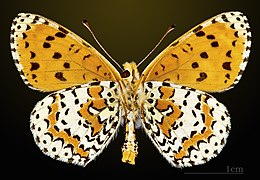Red pied butterfly
| Red pied butterfly | ||||||||||||
|---|---|---|---|---|---|---|---|---|---|---|---|---|

Red moth ( Melitaea didyma ) |
||||||||||||
| Systematics | ||||||||||||
|
||||||||||||
| Scientific name | ||||||||||||
| Melitaea didyma | ||||||||||||
| ( Esper , 1778) |
The red piebald butterfly ( Melitaea didyma ) is a butterfly (day butterfly ) from the noble butterfly family (Nymphalidae).
features
The moths reach a wingspan of 30 to 40 millimeters. A sexual dimorphism can be seen between the two sexes, i.e. they are colored differently. The males are bright orange and have a pattern of black cube spots and cross bars. The females are very variable in color. Mostly the fore and hind wings have a different basic color. Basically, the front wings are gray-brown and the rear wings are orange, each with a black pattern. The undersides of the wings are the same in both sexes: The hind wings are cream-colored and have two orange cross bars and numerous black spots.
The caterpillars are about 28 millimeters long. They are white with numerous bluish-black lines and structures. On their back they have two rows of orange spots from which orange thorns with white tips arise.
Similar species
- Brownish Scheckenfalter ( Melitaea trivia )
Subspecies
- Melitaea didyma meridionalis , Staudinger - North Africa , southern Iberian Peninsula , Mediterranean region , Balkans , Greece
- Melitaea didyma occidentalis , Staudinger - Southern Greece
Flight time
The moths fly in Europe in two generations from mid-April to September, in the warmer regions in three generations from March to October.
Occurrence
The animals are found in North Africa , Europe excluding the North, Turkey and the warm areas of Asia to western China . In the south you can find them up to an altitude of 2,700 meters, in Europe up to 2,300 meters. In Germany they are more common in places, especially in the southern mountainous region, but in some cases they are in decline. They are rare in the north. They live in warm, sunny and dry places, such as B. stony dry grass and rocky southern slopes. In Austria the populations have dwindled a lot everywhere.

Food of the caterpillars
The caterpillars feed on floury mullein ( Verbascum lychnitis ), common toadflax ( Linaria vulgaris ), ribwort ( Plantago lanceolata ), upright ziest ( Stachys recta ), speedwell ( Veronica teucrium ) and various other herbs.
development
The females lay their eggs in piles on the underside of the forage plants. The caterpillars live solitary from the beginning. They overwinter half-grown with a length of approx. 10 millimeters in empty fruit capsules of various plants, such as B. Cowslips . They pupate in June on dried up stems in tumbled pupae that are colored similar to the caterpillars.
swell
Individual evidence
- ↑ a b c d e Heiko Bellmann : The new Kosmos butterfly guide, butterflies, caterpillars and forage plants . Franckh-Kosmos, Stuttgart 2003, ISBN 3-440-09330-1 .
- ↑ a b Tom Tolman, Richard Lewington: The butterflies of Europe and Northwest Africa . Franckh-Kosmos, Stuttgart 1998, ISBN 3-440-07573-7 .
- ↑ Helmut Höttinger, Die Tagschmetterlinge der Stadt Wien , Vienna 1998
literature
- Hans-Josef Weidemann: Butterflies: observe, determine . Naturbuch-Verlag, Augsburg 1995, ISBN 3-89440-115-X .
- Günter Ebert, Erwin Rennwald (ed.): The butterflies of Baden-Württemberg . 1st edition. tape 1 . Butterflies . 1. General part: systematics, taxonomy and nomenclature, faunistics and ecology, endangerment and protection, data processing; Special part: Papilionidae, Pieridae, Nymphalidae . Ulmer, Stuttgart 1991, ISBN 3-8001-3451-9 .
Web links
- Lepiforum e. V. Taxonomy and Photos
- www.schmetterling-raupe.de
- Moths and Butterflies of Europe and North Africa (English)
- Melitaea didyma at Fauna Europaea



